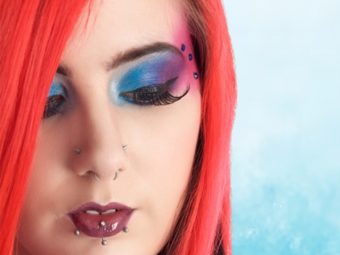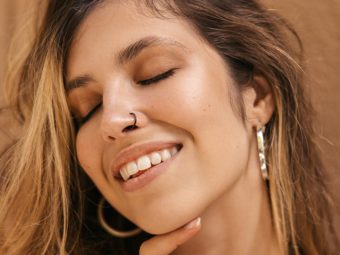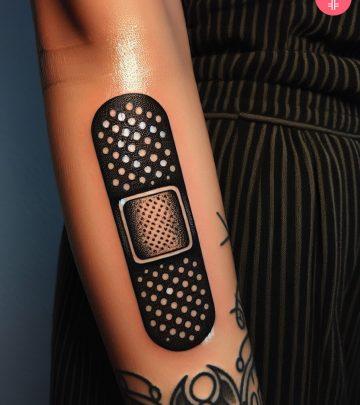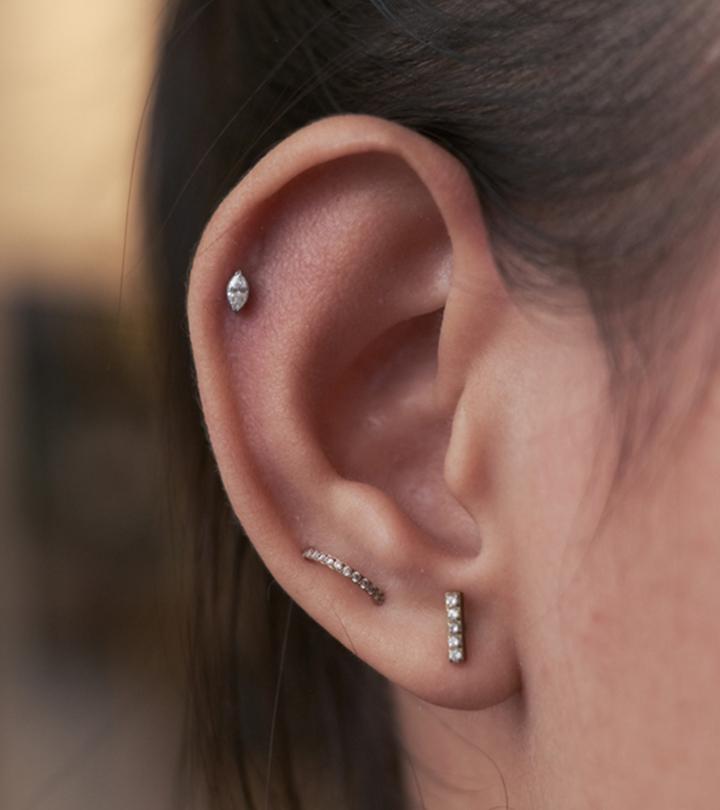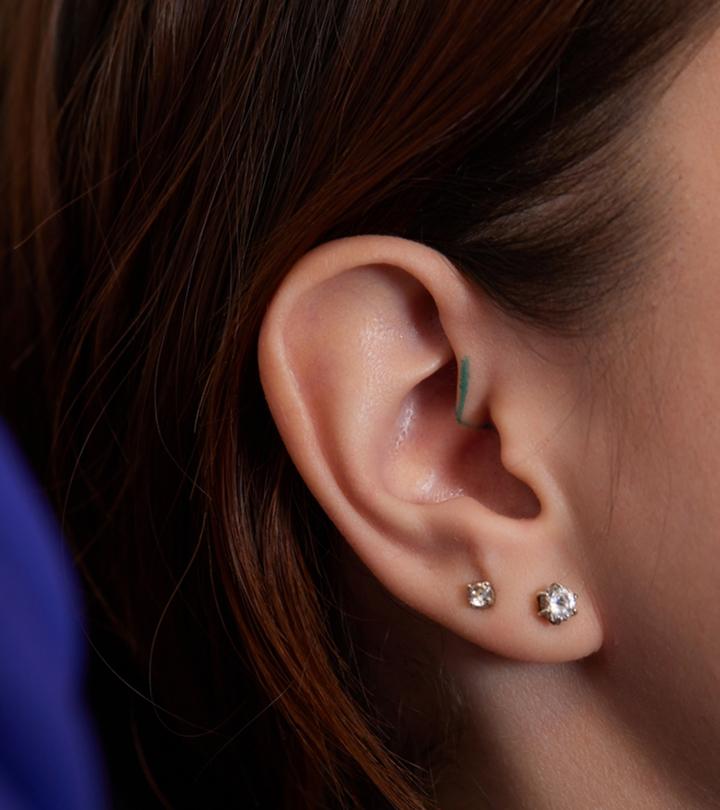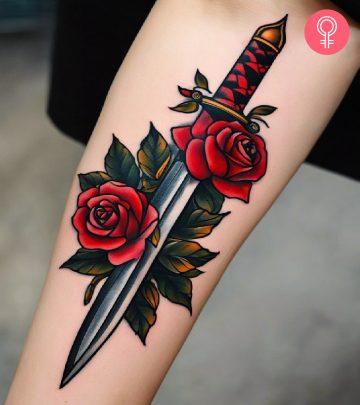Nose Piercings: Types, Cost, Pain, Healing, And Jewelry
Studs or hoops? Find your fit, adorn your face, and uplift your style with ease!

Image: Shutterstock
Nose piercings, with their rich history and diverse styles, continue to captivate the interest of millions worldwide. They have their origins in ancient civilizations and hold historical significance beyond mere aesthetics. Today, the nose piercing has evolved into a mainstream fashion statement. These piercings come as delicate nose studs, bold septum rings, and in various other shapes and sizes to suit everyone’s style.
Whether you are considering getting a first piercing or adding another to your collection, understanding the basics is crucial. In this article, we explore the many different types of nose piercings, the common aftercare practices to follow, and potential risks to look out for. Continue reading to make an informed decision about your piercing journey.
 Piercing Guide: Nose Piercing
Piercing Guide: Nose Piercing- Placement: Through the nose
- Best Jewelry: Nose studs, nostril screws, and captive bead rings
- Cost: $50 to $200
- Pain Level: Mild to high
- Healing Time: 4 to 6 months
In This Article
Preparing For Your Nose Piercing

You may have set your sights on a sparkling nose piercing, but there are some things you need to consider before you dive headfirst. Make a note of the following pre-piercing prep tips to ensure a smooth and successful experience:
- Do not just settle for the first place you see. Research reputable parlors with experienced piercers who specialize in nose piercings. Check their website, their online reviews, and head over to the studios to explore their safety standards and hygiene practices.
 Pro tip
Pro tip- Schedule a consultation appointment with your chosen body piercer to discuss the procedure, aftercare, and any concerns you may have. Do not hesitate to ask them questions! They are there to guide you through the process and address any concerns you might have.
- Discover all the different styles like nostril, nasal septum, or bridge piercings and then choose what suits your aesthetic. Consider how they will fit with your lifestyle and glasses, if applicable.
- Opt for high-quality, hypoallergenic materials like implant-grade titanium or surgical steel to avoid irritation (1). Discuss nose piercing jewelry options with your piercer based on your preferences and budget.
- Ensure you are in good overall health, as any underlying conditions may affect the healing process. If you have any concerns, consult your healthcare professional beforehand.
- Have a light meal before your appointment to prevent lightheadedness during the piercing.
- Drink plenty of water in the days leading up to your piercing. This helps your body heal faster and reduces the risk of swelling.
- If you are taking blood thinners, talk to your doctor about adjusting your dosage before the piercing, as they can increase the risk of bleeding (2).
- Maintain good hygiene by washing your face thoroughly with a gentle cleanser before the appointment.
- Avoid applying makeup around your nose for at least a day before the piercing to minimize the risk of infection.
- Some studios may require identification or consent forms, so bring them along if needed.
- Be prepared to follow a consistent aftercare routine that involves cleaning, aiding the healing process, and avoiding irritation for several weeks.
- Have a close friend accompany you to ease any nerves and provide moral support during the piercing.
In addition to these physical preparations, it is important to mentally prepare yourself as well. Nose piercings can sting, but it is usually a quick pinch. Learn more about the pain levels of this piercing in the next section.
Does A Nose Piercing Hurt?
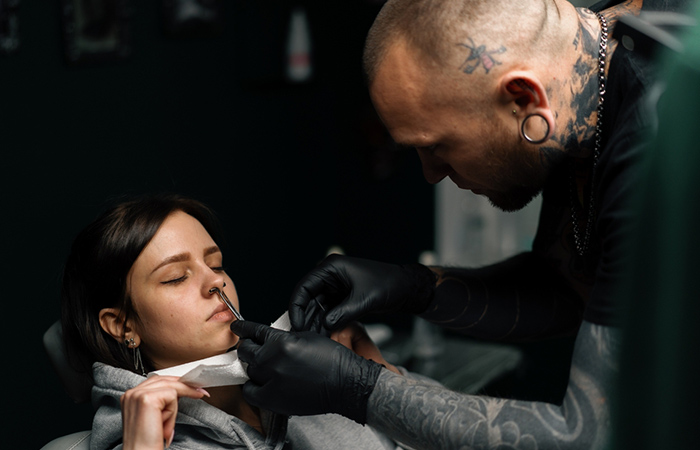
The truth is, pain tolerance varies from person to person. For some, the sensation is akin to a quick pinch, while others may find it more uncomfortable. The good news? The pain felt during a nose piercing is usually short-lived!
Many agree that the discomfort felt during the procedure is brief and manageable. Additionally, the anticipation of pain often feels more intense than the actual piercing itself. Once the piercing is done, the pain reduces on its own. Those with a low pain threshold may feel pain for a few days after the procedure but this will subside as the skin heals.
Cirice, a passionate blogger, finally got a long-awaited nose piercing and shares the experience in her blog. She writes, “About a 3 out of 10, 10 being the worst pain I’d ever experienced and 0 being not painful at all (i).”
However, it is important to note that different areas of the nose have varying nerve densities. Septum piercings, for example, tend to be less sensitive than nostrils. Nostril piercings are generally considered moderately painful due to the dense nerve endings in the area. Additionally, less common bridge piercings may also involve moderate discomfort. Learn more about the types of piercings below.
Nose Piercing Types
View this post on Instagram
Nose piercings come in a dazzling variety. Each offers its own style statement, allowing individuals to express their personality and creativity through body modification. Here are some of the most common types of nose piercings:
1. Nostril Piercing
A nostril piercing, positioned on the outer edge of the nostril, is a classic choice that offers a subtle yet stylish adornment, with a moderate pain level.
2. High Nostril Piercing
View this post on Instagram
A high nostril piercing is placed slightly higher and adds a unique and edgy flair to your look, with a moderate pain level.
3. Multiple Nostril Piercings
View this post on Instagram
Multiple nostril piercings are ideal for those seeking a bolder statement. It features multiple piercings along the nostril that cause moderate to severe pain during the procedure.
4. Septum Piercing
A septum piercing is positioned through the thin strip of tissue at the center of the nose. It offers a versatile option for nose jewelry and can be subtle or eye-catching, but may have a moderate to high pain level.
Note: Be aware that this piercing can occasionally result in a condition known as ‘septal hematoma’. This occurs when there is an injury to the soft tissue within the septum, leading to the disruption of blood vessels and subsequent accumulation of blood and fluid beneath the lining (3).
5. Septril Piercing
View this post on Instagram
A septril piercing is a combination of a septum and nostril piercing. It provides a distinctive and avant-garde appearance with a high pain level.
6. Nasallang Piercing
View this post on Instagram
A nasallang piercing is a complex piercing that passes through both nostrils and the septum. This surface piercing creates a striking and intricate look, but with a high pain level.
7. Double Nose Piercing
View this post on Instagram
A double nose piercing is a symmetrical option involving two piercings on one nostril. It adds balance and flair to your appearance with a moderate pain level.
8. Austin Bar Piercing
View this post on Instagram
An Austin bar piercing is a horizontal piercing through the cartilage on the side of the nose. It lets the wearer make a bold and eye-catching statement with a high pain level.
9. Bridge Piercing
A bridge piercing is positioned horizontally across the bridge of the nose. It creates a unique and daring aesthetic, also with a high pain level.
10. Rhino Piercing
View this post on Instagram
A rhino piercing is a vertical piercing through the tip of the nose. It provides a bold and unconventional look with a high pain level.
11. Third Eye Piercing
View this post on Instagram
A third eye piercing is placed vertically between the eyebrows. It symbolizes spiritual enlightenment and adds an intriguing focal point to your face, with a high pain level.
Remember the type of body piercing will affect the cost and the pain factor. Certain piercings, like intricate nostril configurations or septum piercings with elaborate types of jewelry, may require more specialized techniques and materials, potentially impacting the cost. Learn more about the cost below.
How Much Does A Nose Piercing Cost?
Like any service, prices can vary depending on location, piercer experience, and type of jewelry choice. Expect to pay anywhere from $50 to $200 for the piercing itself. This price often includes the initial piercing jewelry as well. However, high-end studios or specialized piercers may charge more. While a cheaper option may seem tempting, consider the significant differences between a skilled piercer and an amateur, and why that expertise is worth the price.
- A skilled piercer has the knowledge and experience to pinpoint the perfect anatomical location, minimizing pain and maximizing healing potential.
- Amateur piercers may use unsuitable low-quality jewelry, increasing risks of infection and complications. High-quality jewelry is biocompatible, reducing the risk of allergic reactions and promoting healing. This peace of mind is worth the extra cost.
- Professional studios prioritize hygiene, employing rigorous sterilization procedures and using high-quality, disposable equipment. Often, high-end studios and experienced piercers are booked in advance, reflecting their reputation and demand. While it may mean waiting, it signifies their commitment to quality and attention to detail.
- Experienced body piercers will also provide personalized aftercare instructions to ensure optimal healing and minimize complications.
- Also, If you are planning multiple piercings, the cost may increase. However, reputable studios may offer discounts or packages. This makes it more cost-effective to choose experience over affordability.
Remember, investing in a reputable piercer and high-quality jewelry is worth it for a safe and healthy experience. Keep scrolling to learn more about the body jewelry type and material you should go for, for your nose piercing.
Jewelry Types To Be Used In Nose Piercings
A study looked at how men’s bodies react to metals in piercings. They tested 118 men, aged 18 to 43, to see if they were allergic to metals like nickel and cobalt. They found that about 9% of the men had allergic reactions to these metals, especially if they had multiple piercings (4). Most of the reactions were to cobalt, and the main cause seemed to be the jewelry. This shows that men with many piercings are more likely to have metal allergies, especially to certain types of metals like cobalt.
Hence you should choose biocompatible materials that are safe for fresh piercings and sensitive skin, like implant-grade titanium, surgical steel, 14K gold, and platinum. These materials are known to have hypoallergenic properties (1).
 Did you know?
Did you know?Here are some popular jewelry styles you can opt for:
- Studs
- Nose rings
- Horseshoe rings
- Labret studs
- Screws
- L-shaped rings
- Curved barbells/ Circular barbells
- Captive bead rings/ captive rings
- Straight barbells
Your piercer can help you choose the right jewelry based on your preferences and the healing stage of your body piercing. Learn more about the healing period in the next section.
How Long Does A Nose Piercing Take To Heal?
The healing time for a nose piercing varies depending on several factors, including your body’s natural healing ability, the location of the piercing, and how well you care for it.
Piercings in thicker cartilage, like the septum, heal faster than those in softer tissue, such as the nostril. Thicker cartilage provides stability during healing, while thinner tissue piercings may face more movement, prolonging healing.
On average, a nose piercing takes about 4-6 months to fully heal. Remember, it is a marathon, not a sprint! You may experience some discomfort, swelling, and discharge that are all normal parts of the healing process (5).
There are certain factors that can slow down the healing process. Poor hygiene practices and exposure to contaminants can delay the healing of piercings. Additionally, trauma or excessive movement around the piercing site can prolong the healing process (5). If you suspect an infection, watch out for symptoms like increased pain, redness, warmth, and pus-like discharge. Seek medical attention promptly if you notice any signs of infection to prevent complications (6).
During this time, it is important to be patient and follow proper piercing aftercare guidelines to ensure a smooth healing journey. Learn more about some aftercare tips to help you fasten your healing period below.
Nose Piercing Aftercare

Proper care is essential for promoting healing and preventing complications with your nose piercing. Here are some tips or instructions your piercer would share with you (5):
- Clean the piercing twice a day with a sterile saline solution or gentle cleanser.
- Apply the solution with clean hands to avoid piercing rejection and infection.
- Avoid harsh soaps, alcohol, and antibacterial products.
- Avoid touching the piercing with dirty hands.
- Resist the urge to touch, twist, or play with your piercing.
- Do not change the initial jewelry until after the piercing has completely healed.
- Avoid sleeping on the side of the piercing to prevent irritation and further trauma.
- Avoid visiting swimming pools, public water baths, or other similar water bodies to minimize the risk of bacterial infection.
- Avoid applying makeup around your piercing for at least a week to minimize irritation.
If you experience symptoms of infections like excessive redness, swelling, or pus, consult a reputable piercer or a medical professional promptly. Keep reading to learn how you can manage this adverse condition effectively.
How To Treat A Nose Piercing Infection
While proper aftercare may help reduce the risk of infections, sometimes things do not go as planned. If you suspect a bacterial infection, here is what to do:
- Seek medical attention promptly. Contact a healthcare professional or your piercer for guidance.
- They may recommend cleaning the area with saline solution, applying an OTC or prescribed antibiotic ointment, and consuming oral antibiotics if the infection is severe.
- Complete the entire course of medication and follow your healthcare professional’s advice for a full recovery.
- Avoid removing the jewelry on your own, as it can trap the infection inside the piercing.
With prompt and appropriate treatment, you can resolve the risk of infection. However, aside from this major complication, you may experience the following minor ones.
Side Effects Of A Nose Piercing
After having a nose piercing procedure, you may experience the following potential side effects:
- Minor bleeding, crusting, swelling, bruising, and tenderness around the piercing site.
- Some people may also experience allergic reactions to certain metals used in jewelry (4).
- Improper aftercare or trauma to the piercing can increase the risk of infections, scarring, or keloids (7).
- While uncommon with proper aftercare, improper cleaning or using unclean instruments can lead to infections (6).
- Similarly, although uncommon, choosing an unskilled piercer increases the risk of accidentally hitting a nerve, which can cause numbness, tingling, or even permanent damage (8).
Regularly monitoring your piercing and seeking medical attention if you notice any signs of infection may help keep your piercing happy and healthy.
A nose piercing is not merely a fashion statement but a reflection of cultural, religious, or personal identity. From the classic nostril piercing to the avant-garde septum or bridge piercings, there is a style for everyone. However, remember to prioritize your health and safety while flaunting your personal flair. Head over to a reputed piercing studio and get the job done by an experienced piercer who follows the highest safety and hygiene standards. Similarly, understanding aftercare practices and choosing high-quality materials are important steps you should take to ensure a smooth experience. If you notice any prolonged swelling or signs of infection and trauma, immediately consult your physician. So, explore your options, embrace your individuality, and rock your new bling with confidence!
Frequently Asked Questions
When can you change your nose piercing?
You can typically change your nose piercing after it is fully healed that usually takes about 4 to 6 months.
How long does it take for a nose piercing to close?
The time it takes for a new nose piercing to close varies, but generally, the piercing hole can start to close within hours if left without jewelry for an extended period.
What does a right nose piercing mean sexually?
A right nose piercing was historically associated with heterosexuality, but this belief lacks credibility and has no universal significance. It is important to understand that piercings do not inherently signify one’s sexual orientation, and assumptions about someone’s identity based on their appearance should be avoided.
Why does my septum piercing smell?
Septum piercing odor can be due to bacterial buildup, an early sign of bacterial infection. Maintaining proper hygiene and cleaning daily can help alleviate it.
How to tell if your nose piercing is healed?
Signs that your nose piercing is healed include minimal or no pain, swelling, or discharge, and the piercing feels stable and comfortable.
Key Takeaways
- Nose piercings hold cultural and personal meaning and offer a wide range of types and jewelry options, catering to diverse preferences and aesthetics.
- Proper aftercare, such as cleaning with saline solution and avoiding irritation, is vital to promote healing and prevent complications like infections or allergic reactions.
- Prompt attention to signs of infection and seeking medical assistance when necessary are required for maintaining a healthy piercing experience.
Discover the complete guide to nostril piercing in the following video. From pain levels to healing time, learn placement tips and common issues for a seamless piercing experience.
Personal Experience: Source
StyleCraze's articles are interwoven with authentic personal narratives that provide depth and resonance to our content. Below are the sources of the personal accounts referenced in this article.
(i). About My Nose Piercing!
https://ciiriice.wordpress.com/2016/06/02/about-my-nose-piercing/
References
Articles on StyleCraze are backed by verified information from peer-reviewed and academic research papers, reputed organizations, research institutions, and medical associations to ensure accuracy and relevance. Read our editorial policy to learn more.
- Oral and Perioral Piercing Complications
https://www.ncbi.nlm.nih.gov/pmc/articles/PMC2606659/ - “Body modification: piercing and tattooing in congenital heart disease patients”, decoration or disaster?—a narrative review
https://www.ncbi.nlm.nih.gov/pmc/articles/PMC8748479/ - Nasal Septal Hematoma
https://www.ncbi.nlm.nih.gov/books/NBK470247/ - Role of body piercing in the induction of metal allergies
https://pubmed.ncbi.nlm.nih.gov/11526520/ - SUGGESTED AFTERCARE FOR BODY PIERCINGS
https://safepiercing.org/aftercare/ - Body Piercing Infections
https://www.ncbi.nlm.nih.gov/books/NBK537336/ - Clinical Analysis of Lobular Keloid after Ear Piercing
https://www.ncbi.nlm.nih.gov/pmc/articles/PMC5556724/ - Face Piercing (Body Art): Choosing Pleasure vs. Possible Pain and Posture Instability
https://www.ncbi.nlm.nih.gov/pmc/articles/PMC3177080/










